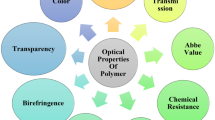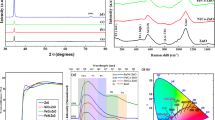Abstract
Epoxy-based copolymers were synthesized with N,N-diglycidyl aniline (DGA) and aniline (An), called poly(DGA-co-An), where azo coupling reactions were performed using amino benzonitrile (ABN) and nitro aniline (NA). Two azopolymers were dissolved with both tetrahydrofuran (THF)/dioxane complex solvent and THF to compare the diffraction efficiencies according to solvent. The thin films spin-cast with THF/dioxane showed the better diffractive efficiency than with THF due to the high boil point of the residual dioxane. The azopolymers of two azo bonds were spin-coated at 800 and 1300 rpm where the thicker film showed the better diffractive efficiency. The epoxy-based copolymers synthesized with diglycidyl ether of bisphenol A (DGEBA) and aniline (An) or 3-hydroxyl aniline (HAn) were coupled with hydroxyl nitro amino benzene (HNAB). Hydroxyl groups in chromophores helped to form hydrogen bonding with the nitrogen atoms in the azo bonds and prevented photoisomerization, showing no surface relief gratings under a normal laser intensity of 100 mW/cm2. Polyurethane-based azopolymers were synthesized with disperse orange 17 (DO17) and toluene-2,4-diisocyanate (TDI), which were no hydroxide groups in the main chains, and showed the better diffractive efficiency than the epoxy-based azopolymers with nitro substituents.
Similar content being viewed by others
References
D. Y. Kim, S. K. Tripathy, L. Li, and J. Kumar, Appl. Phys. Lett., 66, 1166 (1995).
P. Rochon, E. Batalla, and A. Natansohn, Appl. Phys. Lett., 66, 136 (1995).
S. K. Yesodha, C. K. Sadashiva, S. Pillai, and N. Tsutsumi, Prog. Polym. Sci., 29, 45 (2004).
A. Natanshon, P. Rochon, J. Gosselin, and S. Xie, Macromolecules, 25, 2268, (1992).
A. Dhananbalan, C. R. Mendonça, D. T. Balogh, L. Misiguti, C. J. L. Constantino, J. A. Giacometti, S. C. Zilio, and O. N. Oliveira Jr., Macromolecules, 32, 5277, (1999).
V. Zucolotto, J. -A. He, C. J. L. Constantino, N. M. B. Neto, J. J. Rodrogues Jr., C. R. Mendonca, S. C. Zilo, L. Li, R. F. Aroca, O. N. Oliveira Jr., and J. Kumar, Polymer, 44, 6129 (2003).
W. -H. Jung, J. Kumar, and S. P. McCarthy, Polymer Preprints, 46, 903 (2005).
F. C. Krebs, and P. S. Ramanujam, Optical Materials, 28, 350 (2006).
Author information
Authors and Affiliations
Rights and permissions
About this article
Cite this article
Jung, WH., Kim, DY., Kumar, J. et al. Effect of Solvent, Hydrogen Bonding, and thickness of Azopolymer Films on Surface Relief Grating. MRS Online Proceedings Library 889, 504 (2005). https://doi.org/10.1557/PROC-0889-W05-04
Received:
Accepted:
Published:
DOI: https://doi.org/10.1557/PROC-0889-W05-04




